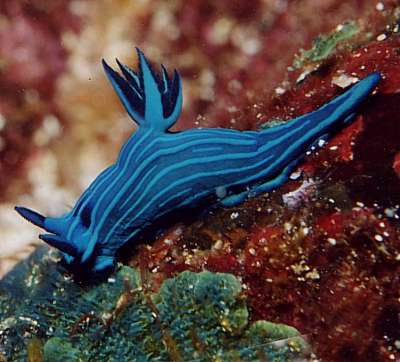
Tambja mullineri
Farmer, 1978
Order: NUDIBRANCHIA
Suborder: DORIDINA
Superfamily: ANADORIDOIDEA
Family: Polyceridae
Subfamily: Nembrothinae
DISTRIBUTION
Known only from the Galapagos Ids, E. Pacific
PHOTO
North Seymour Island, Galapagos Ids. July 2003. 30-40 feet. Approx 20mm long. Photo: Patty Dilworth
Body dark blue with a pattern of lighter blue longitudinal bands. The blue bands are outlined with a thin dark blue black edge. The 5 gill lamellae are dark blue and the broad outer face of each gill is the same lighter blue as the longitudinal bands on the body. There is a thin light blue line up the inside edge of each gill. The rhinophore leaflets are light blue with a dark blue band uo the anterior and posterior midlines.
There appears to be some colour variability in this species. In the original description Farmer describes the background colour as 'ochre-turquoise' and the longitudinal bands as 'turquoise'. A photo by Marc Chamberlain [http://slugsite.us/bow/nudwk124.htm] from Galapagos shows an animal with a black (or very blue-black) background and blue longitudinal bands and a photo by Anne Dupont [http://www.medslugs.de/E/Pac-E/Tambja_mullineri_01.htm] shows animals with a dark green background colour.
-
Farmer, W. M. (1978) Tambja and Roboastra (Mollusca: Opisthobranchia) from the Gulf of California and the Galapagos Islands. The Veliger, 20(4): 375-385.
Rudman, W.B., 2004 (January 19) Tambja mullineri Farmer, 1978. [In] Sea Slug Forum. Australian Museum, Sydney. Available from http://www.seaslugforum.net/find/tambmull
Related messages
More on Tambja mullineri from the Galapagos
October 21, 2008
From: Zeineb Alhaidari
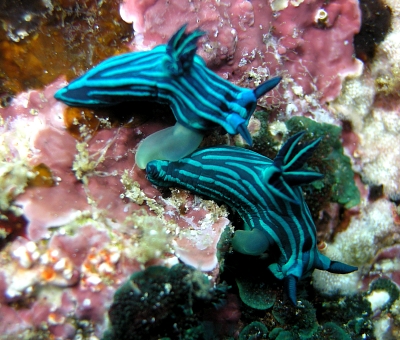
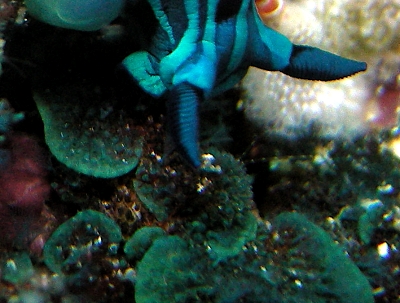
Concerning message #11992:
Dear Bill,
Sorry , these Tambja mullineri are not caught "doing something", but just after mating . I also think they are feeding on the green encrusting bryozoan as it seems to be the case in message #11992.
Locality: Isla Mosquera , 16 metres, Baltra Galapagos, Pacific Ocean, 10 October 2008, Rocks. Length: 30 mm. Photographer: Zeineb Alhaidari.
Very best wishes,
Zeineb
z.alhaidari@wanadoo.fr
Alhaidari , Z., 2008 (Oct 21) More on Tambja mullineri from the Galapagos. [Message in] Sea Slug Forum. Australian Museum, Sydney. Available from http://www.seaslugforum.net/find/21980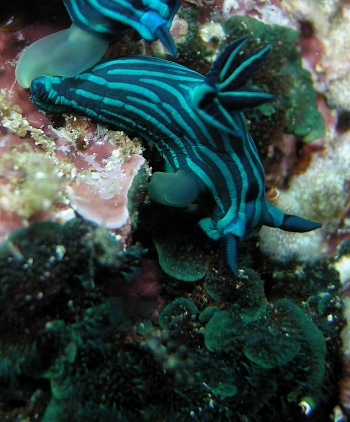
Dear Zeineb,
No need to apologise - a photo of them post mating and by their supposed food, counts as a valuable observation in my book. Although we haven't an identification on the bryozoan as yet, once it is identified I am sure whoever studies the feeding behaviour of this species will find the Forum records to be a valuable addition to our knowledge of its biology.
Best wishes,
Bill Rudman
Tambja mullineri from Galapagos
April 26, 2006
From: Clarke Duncan
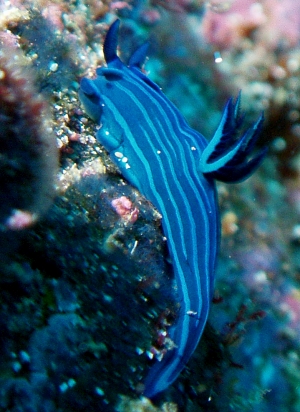
Dear Bill,
Please can you identify the nudibranch in the attached photo. I found this one, which I think is Tambja mullineri, on one of my inital dives in the Galapagos. I would have sent you these photos earlier, but was not aware of this forum until recently.
Locality: Santa Cruz, 15 m, Galapagos Islands, Ecuador, Pacific Ocean, 26 March 2004, Rocky reef with sandy/fine shale bottom. Length: 40 mm. Photographer: Clarke Duncan.
Best regards,
Clarke
clarke_duncan@msn.com
Duncan, C.D., 2006 (Apr 26) Tambja mullineri from Galapagos. [Message in] Sea Slug Forum. Australian Museum, Sydney. Available from http://www.seaslugforum.net/find/16351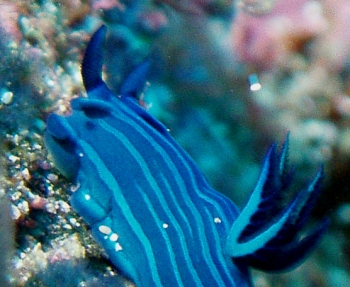
Dear Clarke,
Yes this is T. mullineri which is only known from the Galapagos Ids. I'm glad you have found the Forum - your messages, which I have posted over the last week or so, contain some interesting finds
Best wishes,
Bill Rudman
Species of Tambja from the Galapagos Ids
June 13, 2005
From: Pam McPherson
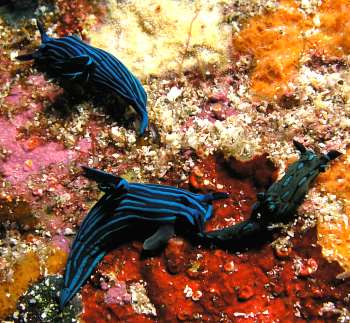
My name is Pam McPherson and I am an instructor on the Kona Aggressor II in Hawaii. I am very "ill" because I have been bitten by the malacology bug and I need help in identifying a nudibranch.
I took the attached photographs on a recent trip to the Galapagos Ids. I have looked in all of the nudibranch identification books and asked the local divemasters and nobody seems to know anything about this nudibranch. Have you seen it before? Can you identify it?'
As you can see in the second photograph, it seems that the Blue-Lined Galapagos Nudibranch (Tambja mullineri ) was attempting to mate with it. Is it common for different breeds of nudibranchs to mate?
Locality: Wolf Island, Galapagos, Ecuador, East Pacific. Depth: 60 feet. Length: One inch. 7 March 2005. reef wall. Photographer: Pam McPherson
Please let me know your thoughts!
Avid nudibrancher desperately awaiting your response -
Pam McPherson
pammcp1@yahoo.com
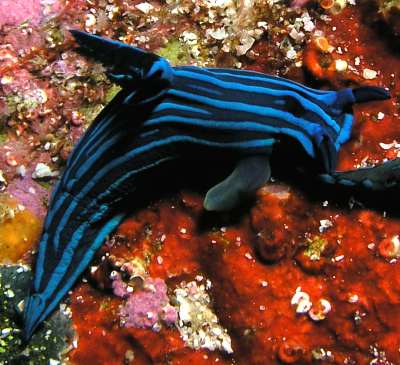
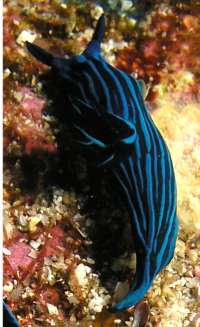
Dear Pam,
Your spotted animal is Tambja eliora, which I discuss in a separate message [#14023]. As far as I know it has not been recorded from the Galapagos Ids before, so that is an interesting find.
There are three species of Tambja with similar colour patterns in the East Pacific. In Tambja mullineri the black gills have a blue outer face and a thin blue line along the inner edge. In T. eliora the outer edge to each gill is coloured khaki in the basal half and bright turquoise blue in the upper half. In T. abdere the outer face of each gill is yellowish and the gill lamellae are a translucent pinkish purple with a blackish tip. There are of course other differences but the gill colour sems to be fairly consistent. Both T. abdere and T. eliora have lined and spotted colour 'forms' but so far, the nearest we have to a spotted form of T. mullineri is the photo in message #12889.
Concerning species mating together. Cross-species mating is certainly not usual. Part of the definition of a species is that it is an isolated genetic entity, and one way to reinforce that are physical and behavioural barriers to interspecies matings. When these barriers break down the off-spring are usually sterile. I think in your photo it is most likely that the lower T. mullineri, with penis everted, has been mating, or at least 'courting' with the upper T. mullineri, rather than with the T. eliora.
Best wishes,
Bill Rudman
Tambja mullineri from Galapagos
January 3, 2005
From: Julianne Parolisi
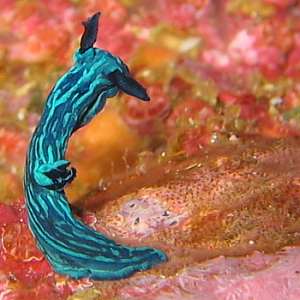
Hi Bill,
Here to accompany my message on Glossodoris sedna from the Galapagos, here is a photo of the endemic Tambja mullineri
Locality: Isabela Island, Galapagos Ids, Ecuador, east Pacific Ocean
Depth: ~3 meters, Length: ~ 1 inch, 4 December 2004. Photographer: Julianne Parolisi
Wishing you lots of beautiful nudibranchs for 2005,
Julianne
aurorable@gmail.com
Parolisi, J., 2005 (Jan 3) Tambja mullineri from Galapagos. [Message in] Sea Slug Forum. Australian Museum, Sydney. Available from http://www.seaslugforum.net/find/12889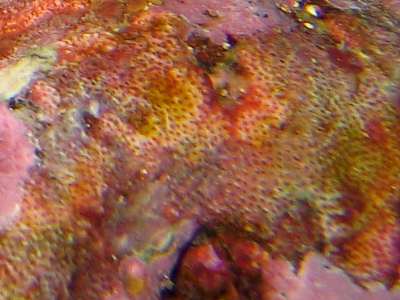
Dear Julianne,
This is an interesting little animal. It would certainly be useful to find what it is feeding on, and something about its reproductive biology. If it is indeed endemic to the Galapagos Ids, it would suggest it has an abbreviated larval stage, which could be indicated by large eggs. So finding an animal laying eggs would be useful.
I have included a close-up of part of the encrusting bryozoan colony your animal is crawling on in your photo. Species of Tambja feed on bryozoans, but usually they are species with arborescent (branching) colonies. The other photo in the Forum of this species [#11992] also shows it on an encrusting bryozoan, so perhaps your Galapagos species is different from others of the genus. Certainly if it is common it would be a nice animal to study
Best wishes,
Bill Rudman
Tambja mullineri from Galapagos
January 23, 2004
From: Patty Dilworth

Dear Dr. Rudman,
Sometimes, the more I look, the more confusing things get for slug identification!
Thank you for your help with this one. I have sent a second similar looking species in a separate message. Both are from a dive at North Seymour Island in the Galapagos during the first week of July, 2003. Both types were quite numerous between 30-40 feet.
This one was approximately 20mm long
Patty Dilworth
padilworth@aol.com
Dilworth, P., 2004 (Jan 23) Tambja mullineri from Galapagos. [Message in] Sea Slug Forum. Australian Museum, Sydney. Available from http://www.seaslugforum.net/find/11992Dear Patty,
This is Tambja mullineri which at present is considered endemic to the Galapagos Ids. This species and the Roboastra in your other message are certainly quite similar in shape and colour, but there the similarity ends. Species of Tambja are bryozoan feeders while species of Roboastra are rather voracious carnivores with Tambja being one of their favourite food items.
Best wishes
Bill Rudman
